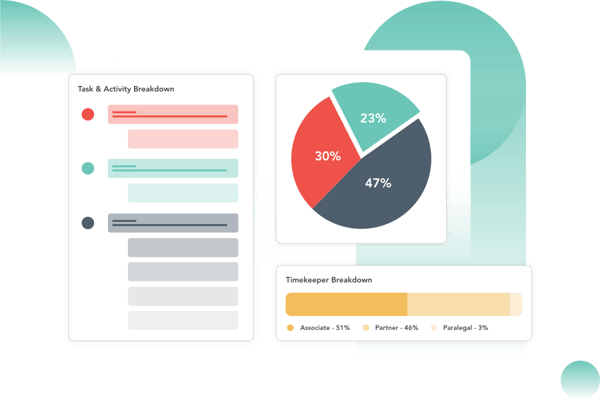October 25, 2023
 by Greg Smoragiewicz / October 25, 2023
by Greg Smoragiewicz / October 25, 2023

Public litigation isn't the same as enterprise legal management
From maintaining legal records to tax filing to electronic estate documentation, enterprise legal management helps a company function in a full legal capacity.
Enterprise legal management is supervised by corporate lawyers and litigators, who overlook company cases, maintain records and employ jurisprudence for critical decisions. With company boards and regulatory bodies calling for transparency, efficiency and predictability, switching to enterprise legal management software puts a clean state on a business's reputation. With dashboard features, you can monitor and control legal costs, file litigations, whistleblow matters and run core counsel operations to comply with the government.
Enterprise legal management or ELM is a litigation system that supports work obligations and major legal operations in a business. With a legal framework, businesses can control their legal spending, arbitrate important decisions, manage legal transactions, e-file or e-verify taxes, file audits and align themselves with business policies set by the government.
Every legal team would have different requirements from an enterprise legal management software. Whether it is the legal team, or external advocate, the software gives a birds eye view into the legalities of an organization.
In-house or external legal clients are expected to support their business counsels on a wide array of topics. Regardless of the subject area, however, all corporate legal services depend on a few common functions to ensure their effective delivery.
The documentation and e-filing system maintains a central repository of due papers, filed claims, circulars, forms, literature, acts, regulations, state and federal submissions and other contracts that are running at present. Taxes and remittances of a company are also stored within the legal documentation management system. The tool makes it easier for legal professional and advocates to view, modify and share certain orders, update legal notices, manage relationships and so on.
Contract lifecycle management streamlines peer-to-peer workflows like e-signature, proposals, accounting processes and legal security contracts. This system gets integrated with the custom enterprise resource planning (ERP) application of a business where users can access specific workflows and contracts. It also houses customer contracts, deals, closure reports, filed claims, lawsuits, complaints and grievances, redressals, resolutions, and trademark and intellectural property rights documentation.
Public record management are official documents and service agreements that are open for public consumption. These notices are available for everyone on the internet to see and are stored on a cloud hosting provider solution. Downloading these documents in a non-editable mode is crucial for well-being of a company's legal health. This includes company updates, funding updates, formal letters, external business letters and so on.
Organizations are powering enterprise legal management with AI to smarten their knowledge repositories and e-discovery systems. Powerful large language models and neural networks are being integrated into reporting dashboards to make data driven decisions. Legal databases are being deconstructed to use data in a much more efficient manner. Comprehensive metrics are being used to determine legal costs, spends, clauses, peer data, competitor reports and insights are being absorbed by legal experts to tap into new policies and guidelines.
Matters are to legal teams what accounts are to sales teams: the individual work units into which many related assets and activities are bundled. Given the increased sensitivity of the work, companies have a responsibility to govern their legal matters with extensive protections and protocols. In fact, matter management begins well before any legal services are performed.
The first task is safe, efficient matter intake. Business colleagues need clear direction on how to initiate requests for legal assistance and what context to include. From there, the in-house legal team will review the request, rate its relative urgency, and evaluate available resources. Once the priority of the matter and the capacity of the team are in alignment, the legal department will assign resources and authorize work to begin.
As the in-house legal team and any outside counsel continue to progress with the matter, the details need to be documented along the way. Business stakeholders, legal contributors, budgets, deadlines, and invoices are just the tip of the iceberg when it comes to what companies must track. Then finally, once the matter is resolved, the team must communicate its outcome through the appropriate channels and consider lessons which could be applied to future projects. Companies resolve hundreds of legal matters in such a way, without relying on manual spreadsheets and emails.
Looking for a practical, cost-effective way to handle disputes before they escalate? Explore the mediation process as a key part of proactive legal management.
Most of the spend management responsibilities held by in-house legal teams would be easily recognizable to any other business department. Each must forecast expenses, track budgets, and strive to limit spending wherever possible.
From a strategic perspective, corporate clients are now adopting more proactive stances in their outside counsel relationships. They’re adopting legal billing tools to clearly articulate their definition of what is – and is not – a valid billable service. They are proposing alternative fee arrangements, such as monthly retainers or volume discounts, which offer superior predictability over hourly billing. And they’re analyzing billing data for more objective clues about what certain activities should cost.
The emergence of specialized legal spend management software is helping teams accelerate each of those strategic ambitions. Digitizing and standardizing invoice management has significantly reduced the administrative effort required to maintain awareness of legal costs.
Automating elements of the invoice review workflow has enabled teams to consistently enforce billing guidelines and quickly reject unauthorized expenses. And the analytical capabilities of modern software have now given tech-savvy teams entirely new data sets to consider when weighing budgeting and resourcing decisions.
In addition to managing matters and controlling costs on a day-to-day basis, legal departments also have a duty to transparently report their progress and analyze the strategic implications. These quantitative exercises haven’t always come easily to in-house legal teams, however.
The most stubborn hurdle has actually been basic visibility. Corporate legal departments have been comparatively late to digitize their operations. As a result, their reporting has suffered from the same accuracy and scalability issues that plague many manual processes. Missing metadata and unexamined invoices can combine to leave significant blind spots in the bigger picture of legal operations.
Two key developments are providing hope, however. The first is the emergence of legal operations as a specialized profession. Legal operators tend to come from more traditional business administration backgrounds and bring a more analytical mindset to the department. In short, they understand which metrics to monitor and which moves to make to get those numbers trending in the correct directions.
The second, related development has been the technical empowerment of legal operations professionals. More departments are realizing the significant returns that can come from investing in software that suits their increasingly analytical ambitions. From simple refinements like visual reporting dashboards to sophisticated innovations like AI-assisted invoice review, in-house legal teams are gradually gaining the technical horsepower required to quickly transform raw data into practical insights.

Best enterprise legal management software should come with a roundtable matter matrix, erosion tracking feature, peer feedback and counsel budget approval feature. Legal cost control is a challenge that corporate advocates face while allocating a fair share of revenue towards litigation activities. Managing these costs with suggestions and real-time feedback from external counsels is a plus point to have in ELM software.
Apart from this, the software should have extensive knowledge management support to transfer documents, modify policies and guidelines and craft legal notices as and when required. This could be a document creation API plugged into enterprise legal management software. Having these features would help scale a team's legal operations on-field and off-field.Enterprise legal management is a continuous process rather than a finite project. It’s an ongoing analysis of how a legal department operates and how it can improve. As a result, teams will often have to ask candid questions and abandon ingrained habits along the way. But on the other side of these minor discomforts lie major rewards.
Accountability is one of those traits you can only really recognize by its absence. When all operational questions are met with quick answers and complete records, it’s easy to assume responsibility and compliance just comes naturally to a team. But when those inquiries are more commonly met with quizzical looks, we’re reminded that accountability is the product of intentional effort.
Enterprise legal management software helps departments develop this trait by first getting work out of individual inboxes and spreadsheets and into a more controlled environment. Managing matters through a central digital hub suddenly makes every legal service visible and trackable by default. This attitude of accountability is then reinforced by the adoption of reliable reporting tools. The knowledge that performance will be consistently and objectively measured naturally raises expectations within a team.
This cultural shift benefits the wider organization as well by helping reduce compliance and security risks by several degrees. The availability of quantitative reports makes it easier for business colleagues to understand and relate to the work being done within the legal department. But most important of all, it establishes the foundation for all future progress. After all, how can teams improve what they can’t see?
Doing more with less is a familiar mandate for in-house legal teams. Considering companies tend to frame their legal function as a cost centre, the question of what can be removed tends to be asked more frequently than what must be added. Thoughtful investments in enterprise legal management, however, can help departments deliver massive results from modest resources.
The transition from manual, paper-based processes to automated, digital workflows dramatically reduces the administrative burden behind legal operations. The effort required to gather law firm invoices and route them to the appropriate reviewers, for example, is effectively eliminated by the proper software. The same can be said of tasks ranging from matter intake to budget tracking. And all these incremental improvements add up to a work week fundamentally refocused around higher-value activities.
The strategic reduction of waste within legal operations also benefits business stakeholders. Corporate finance teams, for example, will have less reason to worry about the submission of non-compliant invoices or the delayed arrival of requested reports. Meanwhile, outside counsel can take heart from faster payment cycles and fewer administrative headaches.
In truth, some business stakeholders will continue to see the ratio of legal expenses to company revenue as the sole indicator of legal department performance. Instilling accountability and increasing efficiency may be welcome improvements, but it’s often the financial implications which are most widely felt.
Investing in smarter enterprise legal management systems can draw valuable cost savings from several sources. Extending financial oversight to cover the full width and depth of a legal service portfolio often brings a few surprising expenses to light for the very first time. Automating elements of the invoice review process ensures fewer of those unauthorized activities reach accounts payable in the first place. But, in the end, analytics will be what hands in-house legal teams their longest and strongest cost control levers.
Translating legal services into practical data paves the way for performance benchmarking. Legal departments can quickly conduct an exhaustive review of their employment-related matters, for example, to develop an objective pricing standard for similar projects going forward. That informational advantage could facilitate the negotiation of more favourable hourly rates or the implementation of fixed fee structures. In either case, the total cost is made more predictable and less substantial from the start.

Beyond enterprise operations, managing day-to-day cases is just as critical. Explore the best legal case management software on G2 to streamline litigation tracking, client communication, and case documentation.
Enterprise legal management software is either used by external counsels or internal legal staff to run in-house legal operations, store legal records, conduct legal verifications or maintain a database of legal activities. This software provides an end-to-end document management functionality that supports spend management, matter management, legal hold, e-billing, knowledge management and analytics for paralegal teams.
To be included in this software list, the software must
This software list has been taken from G2's fall 2023 grid report. Some reviews might be edited for clarity.
Thomson Reuters Legal Tracker is an all-in-one solution designed to empower legal departments and law firms. With its user-friendly interface and powerful features, it streamlines legal operations, simplifies matter management, optimizes financial control, and enhances vendor relationships. This software offers in-depth reporting and analytics, ensuring data-driven decisions. Its seamless integration capabilities make it a valuable addition to your legal tech stack.
Easy-to-use interface. Organized matter list and invoice processing allows you to view and manage your workload and legal invoices efficiently for the intended purpose.
- Thomson Reuters Legal Tracker Review, Kevin K.
I guess if I had to pick one thing to dislike I would have to say creating reports. Sometimes it takes a few tries to understand if you are using the correct options when creating, then you run it to find out it was wrong. Not a major deal, but if it had a real-time data pull to see if that is what you wanted that might help.
- Thomson Reuters Legal Tracker Review, Carrie B.
Brightflag is an AI-powered legal spend management and invoice review software that streamlines the legal invoicing process, optimizes cost control, and enhances transparency. It uses cutting-edge technology to help legal departments and law firms manage their budgets efficiently while fostering better relationships with external legal service providers. Brightflag's intelligent platform offers data-driven insights, promotes compliance, and enables organizations to make informed decisions regarding legal expenditures.
Easy to review legal invoices before payment, relevant information gathered on the platform, better overviews of matters and costs, possibility to report on relevant parameters, user friendly and easy to use. Easy to change settings without involving support. Possibilities for customization, however, not on everything
- Brightflag Review, Astrid S.
It would be nice if there was more useful matter management functionality to the product. I believe having a broader use case would give users a desire to switch.
-Brightflag Review, Joshua S.
SimpleLegal is a user-friendly legal operations management software designed to streamline legal spending, vendor, and matter management, providing a straightforward solution for legal departments to enhance efficiency and control costs. The software offers invoice and billing integrations, a document management facility and cloud integrations to facilitate your legal services.
SimpleLegal is super easy to use. It is both user-friendly and very intuitive to use. The attorneys I support also appreciate how easy it is to use. In addition, SimpleLegal integrates into Oracle, which is what our Accounts Payable Team use to issue payment to our vendors. This integration helps make their job easier and thus ensures quick payment to our firms.
- SimpleLegal Review, Angela M.
The implementation of SimpleLegal and the onboarding of information to the database was a little difficult. Ensuring the correct information was required and uploaded took a while to get organized.
- SimpleLegal Review, Romana T.
Legistify is a growing law and order solution for businesses. This platform is used to upload and store contracts, notices, forms, legal holds, invoices and legal policies and letters. It supports legal formats of documents, fully customisable and automated modules and uses artificial intelligence to provide spending insights.
Legistify provides a suite of features that has significantly enhanced our legal management experience. For instance, the Litigation Search feature boasts an extensive database, which we are able to leverage to gain valuable insights. Additionally, the New Case Alerts feature enables us to stay informed about new cases across India, while the Litigation Management feature empowers us to manage the entire lifecycle of legal matters, including automated case updates, hearing dates, and efficient payment processing.
- Legistify Review, Anshul P.
While Legistify has been a valuable tool for our legal practice, it is important to note that there may be a learning curve involved in adapting to the software's features. However, once we familiarized ourselves with the platform, we quickly realized the immense benefits it offers.
- Legistify Review, Srimoyee B.
ServiceNow Legal Service Delivery is designed to optimize legal department operations. It streamlines legal workflows, enhances service delivery, and offers features such as matter management, contract management, and legal self-service portals. This software empowers legal teams to improve efficiency, enhance collaboration, and ensure compliance, making it a valuable addition for organizations looking to modernize their legal operations.
What users like best:
ServiceNow's legal delivery service impressed with its efficiency, ensuring prompt document handling and clear communication. A game-changer for legal operations.
- ServiceNow Legal Service Delivery Review, Ashram M.
The services may need to be more locally responsive, more variations can adopted based on a detailed market study and depending on the core necessities of the potential customers.
- ServiceNow Legal Service Delivery Review, Md. Rakibul I.

Progress made within any one of the dimensions outlined above will be impressive and valuable in its own right. But the collective impact of these incremental achievements is something altogether grander – a new perception of what corporate legal departments can be.
Instead of regarding law as a strictly subjective business function, in-house legal teams are beginning to see their services as objective, quantifiable activities. And that data-informed perspective is elevating them into more powerful positions. Instead of reacting to the developments of others, they’re more frequently making proactive declarations and confident predictions about what will (and should) happen.
At the same time, their decreasing administrative burdens are enabling them to trade tactical obligations for strategic opportunities. That means more time engaged in the work that not only inspires them professionally, but also contributes more directly to their company’s overall success.
And as these internal changes continue to accumulate, their impact inevitably begins to echo beyond the department. Business colleagues start to recognize and respect their in-house legal team’s commitment to continuous innovation. Then, before long, the dynamic fully shifts. The corporate legal department, a team too-often dismissed as an impediment to progress, finally becomes an equally valued strategic partner.
Don't let the market hold you in contempt. Learn how to draft ethical legal documents to stay at bay from unfair practices and be in police check with legal document drafting software for 2023
Greg Smoragiewicz is the Senior Manager of Communications at Brightflag, where you can find him following the story of how corporate legal departments are rethinking their operations and reframing their value.
I’m not a lawyer, but I know that running a law firm isn’t just about winning cases. It’s...
 by Soundarya Jayaraman
by Soundarya Jayaraman
If there’s one thing I’ve learned watching the legal industry embrace AI, it’s that...
 by Harshita Tewari
by Harshita Tewari
Running a law firm is more than just court appearances and client consultations; it’s about...
.png) by Tanuja Bahirat
by Tanuja Bahirat
I’m not a lawyer, but I know that running a law firm isn’t just about winning cases. It’s...
 by Soundarya Jayaraman
by Soundarya Jayaraman
If there’s one thing I’ve learned watching the legal industry embrace AI, it’s that...
 by Harshita Tewari
by Harshita Tewari


